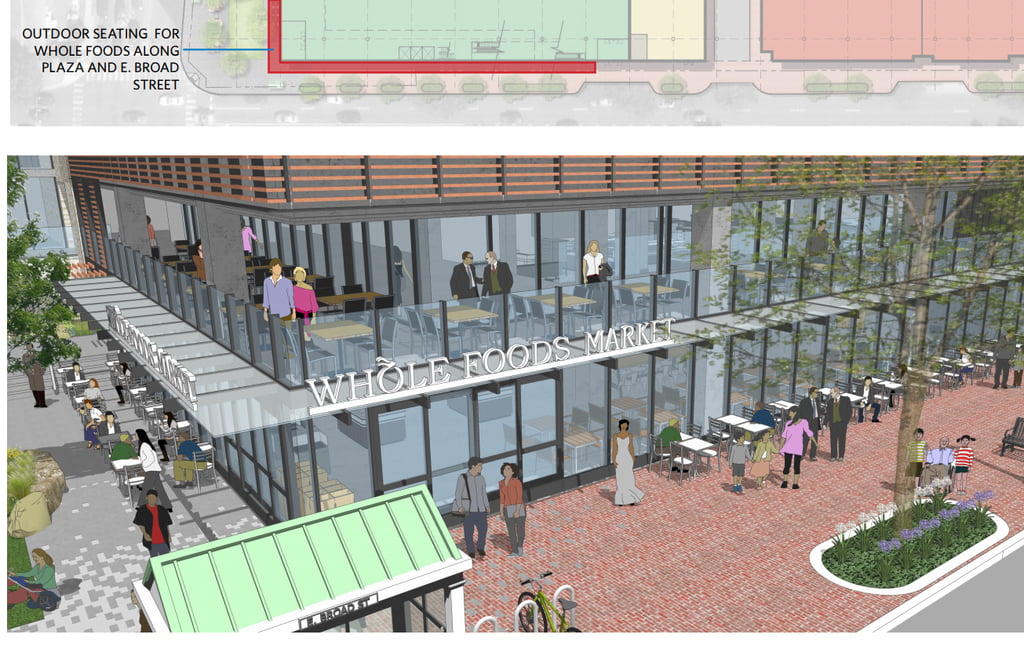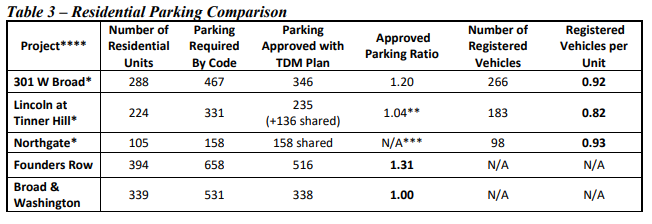Updates from Letty & New FAQs – October 16, 2020
Blog posts are the personal views of Letty Hardi and not official statements or records on behalf of the Falls Church City Council
Dear Friends,
After much deliberation over the past month, we voted to refer the Broad and Washington (aka Whole Foods) project out to boards and commissions, with a 5-0 unanimous vote. Typically, unanimous votes imply that a decision was straightforward, but this was not the case (as evident by the volume of calls and emails I received). With the extra month we took in deferring the project – it dramatically improved, now closer to that elusive “win-win” I had hoped. Still, this is not a done deal and more work is ahead. The project will be reviewed by our boards and commissions, with more opportunity for community input over the next few months. A final vote is planned for January 2021.
Read on about how I got comfortable casting a yes vote. Also, I’ve been fielding a fair number of misconceptions about the project and about mixed use development in general, so it feels timely to refresh the annual FAQ posts I’ve written in the past – with data and links for those who want to dig in further. I hope you find this (long) post useful, whether you’re new to my blog or have been reading for years.
Finally – perhaps just as newsworthy but won’t make the headlines, is that we can expect more sidewalk projects this fall. Sidewalks and crosswalks seem to be the most popular things we do in local government! The City Manager reported that small stretches of “missing link” sidewalks will be installed on S. Maple and S. Oak, which will be a plus when we have elementary students returning to school in November.
Thank you for all the input – know that I do read and thoughtfully consider every comment I receive. Keep up the mask wearing and social distancing, so we can keep return to school in sight.
Take care,
Letty
What Happened This Week:
Broad and Washington – project and land sale advances to board and commission review with 5-0 votes
Quick Facts (see staff report for more details)
- Just over 3 acre mixed used development
- 56K sq ft Whole Foods, 5K sq ft for Creative Cauldron, 6500 sq ft for retail/restaurant – all creating 120 new jobs
- 339 apartments
- Projected annual net fiscal benefit to the city = $1.1M-1.5M (net = after service costs, such as additional public safety, school costs, etc from new residents are deducted).
- Offer to purchase the city parking lot, to be included in the project
- 686 total parking spaces, with 339 dedicated to the residents and the remaining for commercial use (64 free public spaces that replace the current 64 spaces in the city-owned lot, 74 public parking spaces for a fee, 210 parking spaces for Whole Foods – which may also be available for public use)
- Additional benefits: stormwater improvements, LEED Gold certification, traffic light and median cut at Park Place and N. Washington, two public green spaces, affordable housing, EV charging stations, intersection improvements. Other concessions detailed here – including $2.4M in cash contribution to schools, $160K to parks and library.
- 2018 version of this project that included 73K sq ft office building (now replaced by Whole Foods) is no longer financially viable.
- Timeline: if project gets approved and site plan and permitting proceeds on best case scenario timeline in 2021, groundbreaking would occur in 2022, construction would take 18-24+ months, resulting in opening in late 2024.
Changes Since Last Month (more pictures and details here)
- Signed agreements with 2 of the 3 most immediately impacted small businesses – Clare n Dons and Thompson Italian
- Signed agreements for replacement interim parking across the street at Park Place
- Improved tapering of mass and density adjacent to Lawton and Park Place
- Improved architecture

Letty’s thoughts:
It’s not lost of me that we’re talking about any project at all, much less one with a national anchor, in the midst of an unprecedented recession. We’ve taken on a lot of debt – and even if I disagreed with some of it, I have to keep in mind our financial responsibility to those commitments. This development will bring vitality, important revenue, and beneficial second order impacts to the city and nearby businesses, compared to the current uses now. I appreciated that the developer made meaningful improvements and showed a serious commitment to the success of the current small businesses – such that it crossed the threshold for me that boards and commissions should now weigh in.
We should continue to hold a high bar for this important corner. During the meeting on Monday, I outlined additional concerns I’d like to see addressed in the coming months before the final vote – such as mechanisms to ensure certainty of a Whole Foods opening, continue working with businesses and neighbors, architecture, green space, shared parking, affordable housing.
FAQs / top concerns I’ve heard and my thoughts:
“There won’t be enough parking” – I haven’t been around that long, but long enough to know that concerns over parking come up with every development project. As much as we promote multi-modal and invest in Falls Church to be more walkable and bikeable, sufficient parking is still a requirement to ensure a successful project – especially if we want to attract patrons outside the walk or bike radius. At the same time, parking is *really* expensive to build and developers want to build as little as possible, creating a natural tension even within themselves.
With the data provided by staff on actual number of cars in the City’s mixed use buildings (below – 301 W. Broad and Tinner Hill, being the most recent and relevant examples) and not observing any overflow parking into neighborhoods, I’m comfortable with the requested reduction in residential parking. The retail parking also meets code and Whole Foods has asked for parking spaces they deem they need to be successful, so I don’t have concerns with the commercial parking counts either.
“Traffic will be terrible” – traffic is another perennial topic with every development project. While there clearly will be more cars and more residents that come with a project, the traffic study’s main conclusion is that “traffic operations within the study area will be similar with or without the proposed Broad & Washington redevelopment.” The study also re-confirms what we’ve discussed in previous projects: pre-COVID, Rt 7 saw 25,000 vehicles per day and Rt 29 carried 21,000 vehicles per day. With 15,000 residents in Falls Church, our residents and visitors represent a tiny drop in the bucket compared to large volume of regional cars driving on our streets already.
“This will create more flooding” – as stormwater is a top concern in pockets of the city right now, this is an understandable concern. However, with every commercial redevelopment project, we require developers to not create any more runoff than what the site currently creates – usually achieved by large detention facilities. (As the 3 acres is mostly impervious surface today, it likely creates a lot of runoff.) The developers are committing to reducing the stormwater runoff during a 10-year storm by an additional 20% from what’s required in code, so the project should not create flooding to neighbors.
“Our housing values will drop” – another common concern is that current homeowners worry their property values will be impacted by development. As evident from 301 W. Broad and Founders Row – property values in adjacent neighborhoods have not been negatively impacted by those projects. I regularly hear from realtors that walkability to development is, in fact, a selling point.
“The parking lot can’t be sold and can’t be used for mixed use” – the deed that conveyed the parking lot to the city in 1955 does have a restriction that the property would be used for “for public parking of power driven vehicles whether earth bound or air borne” and the parking remain free. The City Attorney confirmed that the deed restriction can be met by our requirement that the developer provide an equivalent number of free public parking spaces on the property at all times, which they’ve made a commitment. Furthermore, the deed does not prohibit other uses nor specify that the land is to be exclusively used for parking.
“We already have too many apartments and too much mixed use. That will bring in too many school age kids. We should have all commercial projects.” I could write a lot here. First, housing should not be a bad word. Pre-COVID, the DC region was projected to grow a lot – over 300K housing units will be needed by 2030 and Falls Church needs to play a part. We can’t put up walls to prevent growth from happening here. The housing that has been built in Falls Church has been fully absorbed, with the newest buildings at over 90% occupancy. As a community, we welcome families of all kinds and sizes – whether you’re single, married, retired, or a growing family. More housing and more diverse housing enables us to welcome everyone.
Contrary to common belief, only about 9% of students live in the new mixed use buildings, out of 2700 kids in FCCPS (2019-2020 school year data). Every year, the “where students live” chart is updated and reviewed as a collaboration between FCCPS and the city. The vast majority of students live in existing neighborhoods or older developments. We can’t prevent the natural turnover that is happening in neighborhoods, which is where most student growth has happened.
So why not commercial-only projects? The retail sector was already undergoing big changes pre-COVID and with the future of office and retail uses now wildly uncertain, mixed use is what the market wants to continue to build. Our mixed use projects have sparked vibrancy we didn’t have 20 years ago, added new amenities and businesses, created housing options we didn’t have, and brought in new patrons to our small businesses and residents who are active members of the community. The overwhelming majority of our mixed use projects also are net positive to the city’s bottom line and contribute significant tax dollars and diversification to our tax base.
Older FAQ posts:
2018 FAQs #2
2018 FAQs #1
What’s Coming Up:
City Council Meetings start at 730 pm, unless otherwise specified. You can access the agenda and livestream here, including recordings of past meetings including virtual Board & Commission meetings: https://www.fallschurchva.gov/471/Watch-City-Council-Meetings